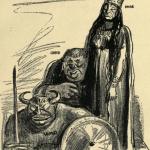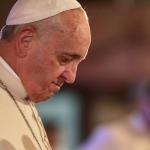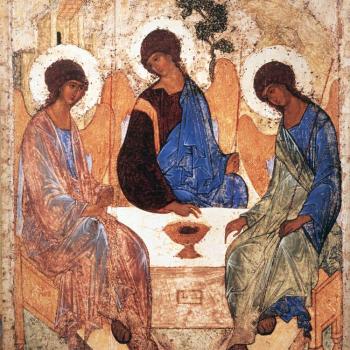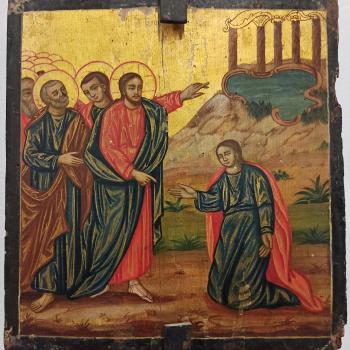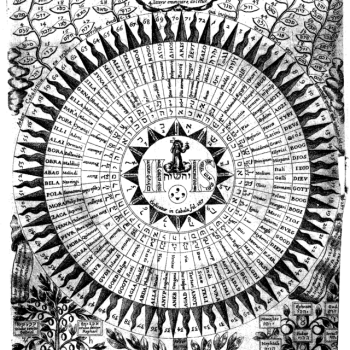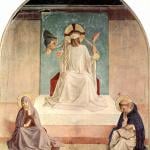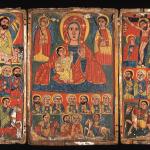For this is veritably to see and to know and to celebrate super-essentially the Superessential, through the abstraction of all existing things, just as those who make a lifelike statue, by extracting all the encumbrances which have been placed upon the clear view of the concealed, and by bringing to light, by the mere cutting away, the genuine beauty concealed in it.
 We are called to see in a sight beyond sight, to know beyond all our knowledge, the beautiful truth which is God. Through grace, through supernatural elevation, we are raised beyond ourselves so that we can see and know super-essentially the Superessential. That is in the Superesential, in God himself, the God who is beyond all things, beyond all being, beyond all distinctive essence in creation, we come to know God. We cannot and will not do it by ourselves with our natural capabilities. In our union with him, all things will be seen and known in him; superessentially we become more than what we are by nature because we become gods by participation in God. We should not confuse what this means; we are to be God by nature but by grace. Through grace, we are united to God; in God, we come to see and know things beyond ourselves because we see and know them by participating in the divine life. Raised up to God, we know all things in God; but to attain this, we must first cut ourselves off from all ordinary seeing and knowing.
We are called to see in a sight beyond sight, to know beyond all our knowledge, the beautiful truth which is God. Through grace, through supernatural elevation, we are raised beyond ourselves so that we can see and know super-essentially the Superessential. That is in the Superesential, in God himself, the God who is beyond all things, beyond all being, beyond all distinctive essence in creation, we come to know God. We cannot and will not do it by ourselves with our natural capabilities. In our union with him, all things will be seen and known in him; superessentially we become more than what we are by nature because we become gods by participation in God. We should not confuse what this means; we are to be God by nature but by grace. Through grace, we are united to God; in God, we come to see and know things beyond ourselves because we see and know them by participating in the divine life. Raised up to God, we know all things in God; but to attain this, we must first cut ourselves off from all ordinary seeing and knowing.
But how are we to understand this? How do we come to know in such clarity of grace? What do we do so that we can be said to ascend outside of ourselves and experience the divine life? Dionysius gives us an analogy: we come to know God similar to the way a statue is formed out a block of stone. Just as Michelangelo suggested that he simply unveiled from the stone what was buried deep within, so we must uncover God from all that we put between us and God, including, and especially, all our thoughts about God. We normally consider God in relation to created being, but this means, he his hid by creation as it becomes our lens by which we know God. Nonetheless, we can slowly remove these layers and let God reveal himself, just like what happens when an artist produces a stature: the stone is chiseled away to show the beauty concealed in it. Thus, we must cut away all existing things from our perception of God, so that the beautiful good truth of God can be revealed, the beautiful truth which is so attractive and good, our hearts can but respond only in love and celebrate that love super-essentially in the Superessential.
We are called, therefore, to act, extracting all the encumbrances which have been placed upon the clear view of the concealed. This is the apophatic turn which is necessary if we are to truly open ourselves up to God and allow God to come to us and reveal himself to us. We must not encumber God with our thoughts and expectations. We must not try to comprehend him with our limited intellect, engaging God in and through worldly similitudes, as if they define who God is. God is beyond all that. We can get an indirect glimpse of God through the analogy of being, but we do not get God himself except when we abandon and silence our way of thought so that we can turn to him alone. This, however, should not be a surprise; even when we try to define and delineate worldly essences, we find that it is not within our power; we describe them, trying to help us know what they are, but in the end, we must also end up relating to them in the ways the various beings in the world are distinguished from each other. Even what is said positively about some entity turns out to be a negation, for to say the sky is blue is to say what is not blue is not the sky. We distinguish and divide up the things which exist in creation, but as we do so, we find out we know them in a way beyond words; we cannot establish essences in words, we can, however, explore what a thing is not, allowing what remains once all that it is not has been removed to be what lies before us in our mind and understood to be the thing itself.
Taking away all that is not God from our understanding of God allows us to come to who God is. But as God lies outside of creation, so we must remove and silence the mind from all thoughts. This is not easy to do, but with grace, it is possible. What we need to do is begin with some simple understandings about God, which help us to know God exists, and slowly purify those understandings, taking away step by step, lesser forms of representation of God, just as a sculptor chisels away at stone allowing the image which is formed to slowly emerge. As we do this, we should be careful and remember, so long as we have not attained God as he is in himself, we are establishing in our mind better and better thoughts about God which are still far from the truth of God in himself. Even great thoughts about God veil God from us and must be taken away if we truly want to come to him and know him as he is in a knowing beyond all human knowing.
How, then, shall we begin? If we want to know that God is, what it is that we do? All things in their own way speak about God as they point to him and imitate him through the analogy of being. We can therefore begin with the analogy of being, looking for the vestiges of God in creation so as to see and know a little about God in a human fashion. Recognizing that this is done through analogy helps remind us that we are not establishing who God is so that we do not end up confusing the ideas we form as the essence of God itself. Analogy relies upon both imitation and distinction; all things are able to imitate, in their own way, God, but they are not God and so where they are distinct from God, we must remove that from our mind. We can, for example, look at a rock, and see some ways in which it can symbolically represent God, but as we do so, we then must remove what is in that rock which is not in God (such as material being), until at last, we have nothing and our mind becomes open to God. Thus, St. Albert explained, “What follows from the separation of all things from God is that he is not one thing among others, as if he were on the same level of all things; but this is not to deny that he is above everything and that everything imitates him.”[1]
In this way, as we remove from our mind all that is to be found in created being, we find God to be nowhere, and therefore, nothing. This is not because he is himself less than existent, but rather, he is the source and foundation of all things which exists. He transcends existence; to get to know him we have to know beyond all things. This means, we will embrace nothing leaving nothing between us and God. We must chisel away all created being, all limited notions of God, so that what lies beyond it, the source and foundation for all things, can be revealed. Likewise, we can, as Ficino explained, see the truth of this by looking within, by seeing qualities associated with God within humanity, allowing us therefore to know God by removing what differentiates us from God from ourselves:
If God made man in His own image, certainly God’s statue is in man, although concealed by accretions. First, therefore, separate body from soul; second, separate bodily passions from the same soul; third, separate the image of the soul’s imagination from the reason; fourth, separate the reason’s discursive arguments from the intellect; fifth, separate the intellect’s multiformity from the soul’s unity itself; and sixth, separate the condition even of being soul or being intellect from this unity. You will come to rest (I thing) on the seventh step. For you will find the absolute Unity itself, that is God, lying concealed under [the soul’s] particular unity. [2]
Here, the quality which Ficino was interested in demonstrating is in the special Unity of God, the divine simplicity which makes God one. He observes how, through denying what is not like God in ourselves, we can rise up from ourselves until we discern the Oneness of God, for we see in ourselves, a similar but distinct (compounded) oneness. He starts with body and soul, but then discerns God is not a body and so negates all that is bodily from our conception of God so that we can discern God as spirit. But then in doing so, he discerns how our soul is compounded in nature, allowing it to be filled with passions, thoughts, imaginations, and the like, which divide up the soul; each of them, likewise, are created things which are not God, and cast aside until at last, even the highest aspects of our soul are cast aside and what we have left is a simple spiritual unity which approximates for us the notion of the simple unity of God (for Ficino leaves us in the realm of conventions, showing how in and through conventions, we can rise up apophatically to better and better concepts of God).
It is important for us to realize two things when talking about God: how what we produce ends up being at best an approximation of the truth established in our intellect and also that there is a gradation of such thoughts, so that some approximations are better than others. We can encounter God in all things, see God in all things, but yet they are all not equally representing and establishing God. As we see the form of a face begin to emerge as a sculptor chisels away at stone, so we can see better and greater representations of God being established as we slowly negate all that is not God from our approximations about God, until at last, all is cast aside and we find ourselves open to dwelling superessentially in the Super-Essential God himself, and when we do, we behold how beautiful he is and find ourselves one with him in love.
[Image=Sculptor of WSSA (World Sand Sculpting Academy) at work in The Hague, Buitenhof by Apdency (Own work) [Public domain], via Wikimedia Commons]
[1] St. Albert the Great, “Commentary on Dionysius’ Mystical Theology” in Albert & Thomas, Selected Writings. Trans. Simon Tugwell, OP (New York: Paulist Press, 1988), 175.
[2] Marsilio Ficino, Mystical Theology in Marsilio Ficino: On Dionysius the Areopagite. Volume I: Mystical Theology and The Divine Names, Part I. trans. And ed. Michael J. B. Allen (Cambridge: Harvard University Press, 2015), 53. In the same chapter, Ficino offers other ways in which we can abstract from created things the truth of God, such as how we can abstract what is not God from the world to find the Good beyond understanding, or how we can abstract from the sun all that is material in the sun, we can ascend to the source and foundation of light itself in God, the “sun’s Sun” (55).
Stay in touch! Like A Little Bit of Nothing on Facebook


